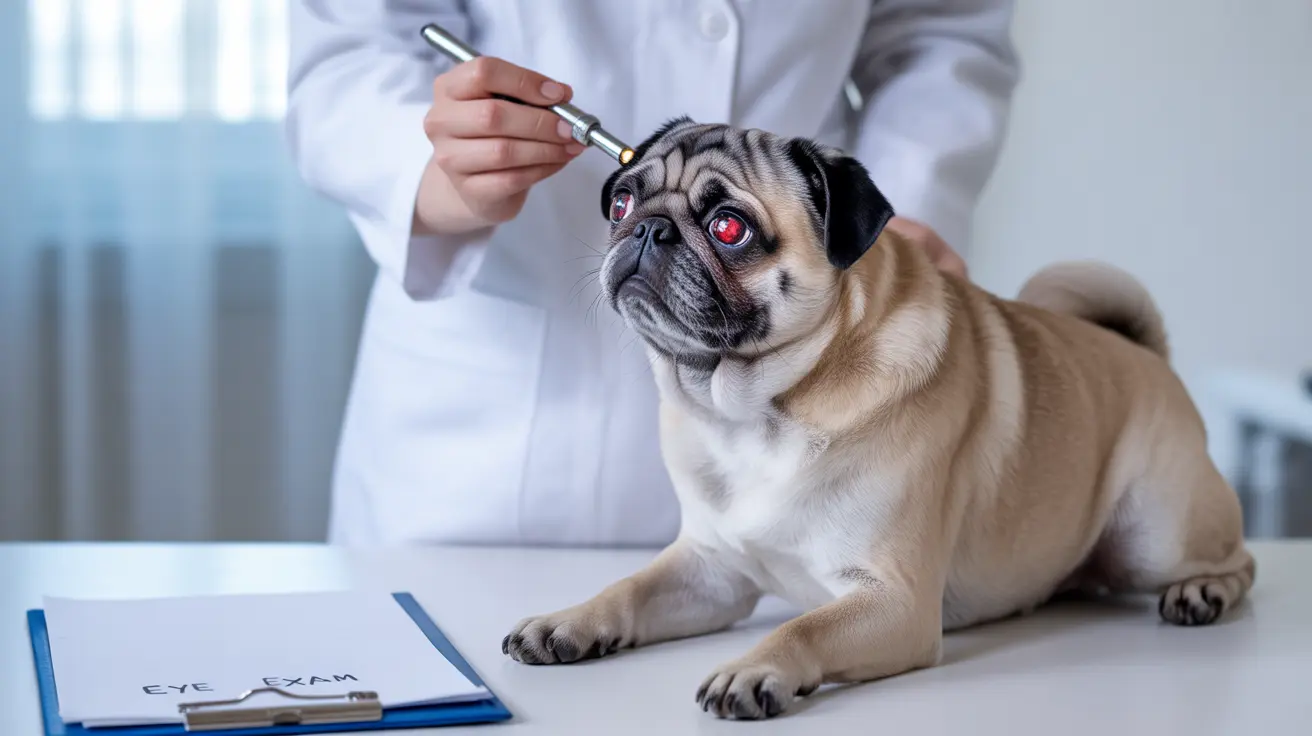Introduction
When your dog's eyes appear red or bloodshot, it can be a concerning sight for any pet owner. Red eyes in dogs can range from minor irritations to serious medical conditions that require immediate veterinary attention. Understanding the various causes, recognizing symptoms, and knowing when to seek professional help is crucial for maintaining your dog's eye health and overall well-being.
This comprehensive guide will explore everything you need to know about dog eye redness, from common causes and symptoms to treatment options and preventive measures. Whether you're dealing with a case of simple allergies or facing more serious conditions like glaucoma, this information will help you make informed decisions about your pet's eye care.
Understanding Different Types of Eye Redness
Episcleral Injection and Blood Vessel Changes
When examining dog eye symptoms, one of the first things veterinarians look for is episcleral injection. This refers to the engorgement or prominence of blood vessels in the white part of the eye. Episcleral injection is often a sign that something more serious is happening within the eye, such as glaucoma or uveitis. These conditions can threaten your dog's vision or even their overall health if not treated promptly, so any significant change in the appearance of eye blood vessels warrants veterinary evaluation.
Conjunctival Hyperemia and Surface Inflammation
Conjunctival hyperemia in dogs presents as an increase in blood flow to the surface membrane covering the white part of the eyes. This causes the eyes to appear pink or red and is a common response to various forms of irritation, including allergies, minor injuries, or infections like conjunctivitis. Owners should monitor for additional symptoms like squinting, discharge, or swelling, which may indicate the need for veterinary care.
Common Causes of Red Eyes in Dogs
Allergies and Environmental Factors
Allergies are a frequent cause of red and irritated eyes in dogs. Environmental triggers such as pollen, dust, mold, or even household cleaning products can lead to itchy, watery, or bloodshot eyes. Dogs may also react to shampoos, perfumes, or certain foods with similar symptoms. To help minimize allergy-related eye issues, keep your home environment clean, use hypoallergenic bedding, and limit exposure to known allergens. If allergies are suspected, consult your veterinarian for guidance on allergy management and possible medication.
Infections and Inflammation
Eye infections in dogs, caused by bacteria, viruses, or fungi, can result in pronounced redness, discharge, swelling, and discomfort. These infections may arise from contact with contaminated objects or as a complication from systemic illness. Prompt veterinary attention is essential for accurate diagnosis and treatment, typically involving prescription antibiotic or antiviral eye drops, and sometimes oral medications. Left untreated, infections can cause serious eye damage and vision impairment.
Trauma and Injury
Physical injury to the eye, whether from play, roughhousing, foreign objects, or accidents, can lead to immediate redness and sometimes bleeding or visible wounds. Even minor injuries can progress to infections or more extensive damage, especially if the dog continues to rub or paw at the eye. Any suspected eye trauma should be promptly evaluated by a veterinarian to assess the extent of the injury and initiate appropriate treatment to prevent long-term complications.
Recognizing Serious Conditions
Glaucoma and Vision-Threatening Issues
Glaucoma in dogs is a critical condition marked by elevated pressure within the eye. This pressure escalation leads to redness, pain (often shown by squinting or excessive tearing), and changes in the appearance or health of the eye. Untreated glaucoma can very rapidly result in blindness and is considered a veterinary emergency. Prompt recognition and treatment can save your dog's vision and alleviate discomfort.
Dry Eye Syndrome
Dry eye syndrome, also known as keratoconjunctivitis sicca, affects many dogs and can cause chronic redness, thick discharge, and noticeable discomfort. The underlying issue is decreased tear production, leaving the eye vulnerable to infection and injury. Management of dry eye typically involves regular administration of artificial tears, immune-modulating eye medications, and, in some cases, surgical intervention. Lifelong monitoring and treatment often yield the best outcomes for affected dogs.
Treatment Approaches
Professional Medical Care
Treatment for red eyes in dogs varies significantly depending on the underlying cause. Your veterinarian may utilize several approaches, including but not limited to:
- Antibiotic or antiviral eye drops: Used to treat infections and control microbial growth.
- Anti-inflammatory medications: Help reduce swelling and discomfort, often prescribed for allergies or immune-mediated conditions.
- Specialized treatments: For specific issues such as glaucoma, eye pressure-lowering drops or medications may be required, and in advanced cases, surgery might be recommended.
- Surgical intervention: In cases of severe trauma, chronic dry eye, or unresponsive glaucoma, surgical treatments can help preserve eye structure or relieve pain.
In every case, accurate diagnosis from your veterinarian is essential to ensure optimal treatment and a favorable prognosis.
Home Care Strategies
In addition to professional veterinary care, supportive home management can greatly aid your dog's recovery and comfort. Key strategies include:
- Keeping the eye area clean by gently wiping away discharge with a soft, damp cloth.
- Administering all prescribed medications exactly as directed by your veterinarian.
- Observing your dog daily for any changes, including increased redness, swelling, discharge, or evidence of pain.
- Preventing your dog from scratching or pawing at the affected eyes. Consider using an Elizabethan collar if necessary to prevent self-injury.
Never attempt to use over-the-counter human eye products on your dog without veterinary direction, as these can cause harm.
Prevention and Monitoring
Proactive monitoring and care can help prevent many cases of red eyes in dogs or catch issues early when they are most treatable. Establish a routine of checking your dog's eyes for any signs of redness, cloudiness, excessive tearing, discharge, or swelling, especially if your pet belongs to a breed predisposed to ocular issues. Regular grooming, keeping facial hair trimmed, and maintaining overall cleanliness around the eyes reduce the risk of irritation.
For dogs with chronic conditions or allergies, working closely with your veterinarian to develop a long-term management plan is vital. Vaccinating against common infectious diseases and avoiding eye trauma during play can also help keep your dog's eyes healthy.
Frequently Asked Questions
- What are common causes of red eyes in dogs? Allergies, infections, trauma, dry eye, and serious conditions like glaucoma can cause redness.
- What symptoms suggest my dog's red eyes need urgent care? Persistent redness, discharge, swelling, pain, or vision changes require a vet visit.
- Can allergies make a dog's eyes red? Yes, environmental and food allergies often cause eye redness and itchiness.
- What is conjunctival hyperemia in dogs? It's increased blood flow in the eye's surface, often making the eyes appear red.
- How do vets diagnose the cause of red eyes? They perform an exam, check for injury, infection, and may run lab tests.
- Is it safe to treat red eyes at home? Minor irritation can be managed with dog-safe saline, but a vet should check persistent issues.
- Which breeds are more prone to red eyes? Breeds with prominent eyes or facial folds, like Pugs and Bulldogs, are more susceptible.
- What treatments are available for red eyes in dogs? Depending on the cause, treatments may include eye drops, antibiotics, anti-inflammatories, or surgery.
- Can red eyes in dogs be prevented? Regular eye checks, hygiene, and prompt care for allergies or injuries help prevention.
- When should I call a vet for my dog's red eyes? If redness lasts over a day, worsens, or is paired with pain, vision loss, or discharge, seek veterinary help.
Conclusion
While some cases of red eyes in dogs may be minor and resolve with simple care, others can be a sign of more serious health issues. Recognizing the difference is essential for your pet's well-being. When in doubt, always consult with your veterinarian to ensure a proper diagnosis and prompt treatment for your dog's eye condition. By staying vigilant and informed, you can help protect your dog's vision and overall health for years to come.






